Migrant and Refugee Children at Slovenian Schools
Introduction
Slovenia is both a host country and a country of passage for migrants and refugees. As such, it is confronted with various challenges. In my fieldwork, I was interested in how Slovenia was handling the issue of the integration of migrant and refugee children into Slovenian schools. Slovenia has had many migrants and refugees resettle within its borders. To begin with, there were the economic migrants during the Yugoslavian era. Then from the 1990s onwards, there were the refugees from ex-Yugoslavia seeking asylum. And after these refugees, are the refugees from the Middle-East who are currently seeking asylum in Slovenia. How does a state and its society deal with the multifaceted challenges, the diversity and the multiculturality that accompanies this situation?
Which concepts exist to organize everyday school life for children and teachers, everyday life for families and the receiving society? Which problems need to be overcome? What measures have been taken to promote and facilitate the inclusion of these children?
Through literary and internet research, I was able to determine my research topic, and thanks to the help and advice of Saša Istenič, who accompanied our seminar, I was able to make contacts in Slovenia and arrange interviews. Saša, a scientist at the Institute of Slovenian Ethnology, deserves a big thank you because she was able to provide us with valuable information and corresponding contacts for all our research topics. That helped us enormously. I was able to obtain important information by observing a school because while I was there, many things became clear to me through the liveliness of everyday life at the school.
At their request, I anonymized my interviewees and I also changed the name of the school. The quotes of Schiffauer, Kymlicka and Ariëns have been translated by me.
Background
Slovenia is a country with a rich history of migration. During the time of the former Yugoslavia, workers migrated for economic reasons, mainly from the southeast of Yugoslavia to Slovenia, which was able to offer many jobs due to its advanced industrial and urban development. The collapse of Yugoslavia (Slovenia declared its independence in 1991) and the subsequent Yugoslav wars resulted in increased migration from these countries, particularly from Croatia between 1991/92 and later from Bosnia and Herzegovina. After this period, the topic shifted to forced migration, refugee policy and asylum. In 2014/2015, there was the great refugee crisis which saw many people flee from the Middle East in order to escape war and death. These refugees mainly came from non-EU countries such as Afghanistan, Syria, Iran and Iraq. These refugees were far more diverse than the previous migrants, as far as language, culture, religion and politics are concerned.
Between 1995-2015, 19,889 asylum applications were submitted in Slovenia but only 393 applications were successful. In 2015 and 2016, about half a million refugees passed through Slovenia. In 2015, there were 277 asylum seekers, 45 of whom were granted asylum. And in 2016, out of 1,308 applications, 170 were accepted. These figures show that in comparison with Austria, Slovenia is not very generous in granting asylum status.
Nevertheless, this situation posed new challenges for the country, and especially its educational institutions because not only the asylum children but also the migrants and refugee children without status had to be cared for.
After researching the migrant and refugee situation in Slovenia, several questions arose for me: questions about the integration of these people, about multicultural communication and also about learning as a complex process between the migrants / refugees and the majority of the host society (see Daniel Neugebauer’s text about host society). How should one deal with the large number of refugees? What measures should be taken, especially for the children, concerning their education, training and their integration into Slovenian society? How is this multicultural society received? And, how is diversity handled?
In 2006, sociologist Simona Zavratnik pointed out that it was to be expected that migration would increase in the near future and that people would come from even more diverse social, economic and cultural environments. Therefore, it would be advisable to advocate the integration of migrants into society. At the same time, it would be important to support intercultural communication in the form of a two-way process of learning and exchange of information between migrants and the receiving society (Zavratnik, 2006: 348). As we know, her predictions regarding refugee numbers and diversity have come true and the challenges that have arisen, especially those concerning children, interested me. How could this „intercultural communication“ take place and how does the integration of migrants into society happen, given that it is a two-sided process? Which social vision could be derived from this?
Throughout my research, it became clear that a lot of effort has been put in in order to provide solutions to these questions:
On the one hand, an extensive teacher training program – „Le z drugimi smo“ – has been developed, which deals predominantly with the topics of migration, diversity, and interculturality. I have had the opportunity to speak with Mrs. M., who, together with other experts, has developed this program for teachers which enables them to respond in a particular way to the diversity of children. It also enables teachers to create individual learning programs and to put the programs online as a learning process and model for other teachers. She has paid particular attention to the challenge of working with migrant children and was – and still is – seeking solutions.
On the other hand, the Mavrika Elementary School in Ljubljana was recommended to me as the best practice model. This elementary school is located outside the center of Ljubljana, not far from the homes of the migrants and refugees. 98% of the children attending the school are migrants and refugees, and thanks to the dedicated director and a large number of teachers, the school has successfully assisted the students in their learning and development. 333 children from 27 nations and 8 languages are currently represented at this school. Through daily practice and confrontation, ways and methods are invented and found in order to cope with the problem as will be explained below. By observing the school, I was able to get some insight into the everyday school practice, the resources the school has and I was also able to conduct interviews.
Examples of inclusive measures for migrant and refugee children
1. „Le z drugimi smo“
„Le z drugimi smo“ is a continuing education program that helps teachers working in all levels of education to teach and deal with migrant children. The reasons to develop such a program are manifold. As the expert told me, the country of Slovenia became more and more divided during the arrival of the wave of refugees in 2015/2016. On the one hand, there were the helpers and supporters of the refugees, and on the other hand, fear and intolerance from many sections of the population, which were intensified by the media and politics (the media spoke about the „refugee wave“, the politicians about the „security issue“ and so on). Prejudices have become stronger and teachers are feeling increasingly insecure due to the lack of knowledge of the students. Parents in the town of Logatec managed to ensure refugee-children and unaccompanied minors could not enroll at the local school. But this was not possible because Slovenia has general compulsory education. Thus, the Ministry of Education, Science and Sport has decided to distribute immigrants and refugee children among the primary school classes, and at the same time to invest in training (with programs such as „Le z drugimi smo) for (overburdened) teachers (Vižintin, 2018: 95).
In Ljubljana, employees of the Research Center of the Slovenian Academy of Sciences and Arts, the Slovenian Migration Institute, which deals with the interdisciplinary research of international migration, as well as the many aspects of emigration and immigration, and the Educational Research Institute, dealing with the diverse forms of education, have developed the program „Le z drugimi smo“: „Only (with) others are we“. The aim of the program is „strengthening the social and civic competences of educational staff“. This project is supported by the Republic of Slovenia and the EU, through the European Social Fund.
The goal is to „train professionals and leaders in all fields of education from preschool to adult education“ (Vižintin, 2018: 98). This program is scheduled for 5 ½ years, 2016-2021, and is extremely extensive and challenging. Through five (free) seminars each lasting 16 hours, knowledge in the following areas is taught: 1. Living the diversity: Immigrant Inclusion, Slovene language and Multicultural Dialogue; 2. Zero tolerance for violence: Challenges and Issues; 3. Respectful Communication and Conflict Management; 4. The Challenges of Modern Society and School; 5. Intercultural Relations and Integration offered in Education Practice (Vižintin, 2018: 98). Information on the legal situation, human rights, psychology, cultural differences, health and civics are also part of the program. This training should enable teachers to develop individual programs for each schoolchild and – hopefully anonymously – put them on the internet so that others can learn from them using these examples. The project has only been running since 2016, but successes are slowly becoming visible, as my interviewee confirmed:
„So, the work is in progress now and in my opinion, it is much better than it was because a lot of schools are really dealing with it. And I wrote some suggestions. Also to the ministries here. I suggested to the Ministry of Education that students that study now and will be teachers someday, need those topics about inclusion, about Slovenian as a second language, about intercultural competence, about intercultural dialogue. So that they are prepared when they go into classes. We speak different languages, we follow different religions. This is the topic, it can talk about it, at history, at geography, at Slovenian lessons, at English lessons, at biology [The seminars will be useful in any subject whether it is in history, geography, Slovenian lessons, English lessons or biology]. I always say: Why not?“ (Mrs. M.)
In the following I would like to highlight several points of this program.
Intercultural Education – Intercultural Integration Model
An integral part of the “Le z drugimi smo” program is a seminar called „Living the diversity“. An important part of this seminar is dedicated to „intercultural education“ or the „intercultural model of integration“. My interviewee points out that, according to Bester/Medvesek (2016: 30), there is no standard definition of the concept of „intercultural education“ or „intercultural competence“ and that no global agreement exists (according to Boecker, 2008: 13) (Vižintin, 2018: 90). Thus, she would like to highlight the intercultural approaches that teachers in Slovenian schools have developed during their daily work with migrant children and the challenges for better inclusion associated with this, as well as to add her own recommendations to teachers.
Interculturality is to be seen as a pedagogical-didactic principle, which, when applied to the planning, execution and evaluation of the education, induces a change in the hierarchical relations between the dominant ethnic / cultural majority and the minor ethnic / cultural minorities. The „Other“ should be treated equally. Furthermore, the pedagogical process should enable minorities to accomplish higher achievements and develop common values.
As an educational principle, it should serve as a guideline for teaching, both at the formal level (such as curricula, textbooks, educational programs) and in practice.
Thus, textbooks should be examined for ethnocentric stereotypes, negative representations and racist perceptions of the „other“. Also, textbooks should take into account the different ethnic groups. Syllabuses should be designed together with migrants. The academic programs of the faculties of education and arts should include content about multicultural society, multilingualism, multi-ethnicity and multi-religiosity (Vižintin, 2018: 92).
Teachers should be encouraged and strengthened for social interaction with different cultures. In class, children could, for example, design biology, history, or geography lessons and report from their respective areas of origin, giving new insights to other children and teachers, while encouraging mutual learning. However, there is the danger of culturizing difference. Stereotypes that put the children back into a certain „picture“, into a long-standing „idea“ may start to arise. It may be the case that children should talk about a country or about a language they have little idea about because they have never been there, or because it was too long ago, or because their language is not spoken enough. It is also possible that the children want to delineate themselves because they want to integrate themselves into the respective country. Werner Schiffauer has already pointed out the danger of this. In the study of a Berlin school with Turkish migrants, he notes the problem of exclusion despite the good will of the teachers: „Curricula and textbooks signal to immigrants that they do not belong to the rest. This may be underlined rather than attenuated by lesson plans designed by highly motivated teachers specifically because of immigrant children.“ (Schiffauer 2001: 249, author’s translation)
Language
A second focus of the program concerns language, more specifically, language acquisition. In this case, we are talking about learning Slovene as a second language. So far, teachers are not trained for this, but through the program, they will receive an additional qualification in language acquisition. Also, the native language is given high priority. The program aims to make teaching the acquisition of a new language much easier. Special attention is paid to reading and libraries. So, my interview partner wishes that in each school library there are not only Slovene books but also books in the languages or the other nations represented in each school so that these children can read in their native language and thus are able to progress in their mother tongue. In class, fairy tales in the languages of the refugees could be presented and compared with Slovenian fairy tales. Through this, the class and teacher start to learn the respective migrant/refugee languages, and they also learn the other spelling or a sound that is similar to their own language. In this way, the lessons can be lively and exciting for children and teachers while at the same time promoting mutual learning and respect.
Mrs. M. pointed out that, especially with regard to the textbooks for Slovenian as a second language, great progress has been made. While previously only textbooks for adults or didactic material for teachers abroad existed, you can now find many work- and textbooks for kindergarten and school.
This program provides teachers with extensive knowledge and understanding of students‘ different situations. It enables them to respond to specific situations and problems. The teachers receive a high level of aptitude and safety at various levels in order to be able to organize the lessons appropriately. In order to implement these guidelines, one needs ambitious teachers who invest a lot of time and energy in their efforts to integrate children with the rest of the class.
While “le z drugimi smo” represents a top-down perspective, I was interested in the way the teachers “on the ground” deal with the challenges connected to migration. After all, it is the many dedicated teachers who are looking for new ways and inventing new methods to keep up with the varied and extensive requirements and to support the children in the best possible way.
The Mavrika Elementary School in Ljubljana was recommended to me by various sources as being a very good example of a school which is working tirelessly to integrate refugee and migrant children with the rest of the pupils. Here ideas have been developed for many years in order to support and promote migrant and refugee children as well as possible and to prepare them for their role in society. Mrs. M. also highlights this school as being particularly special:
„Mavrika school is a special school. … I enjoy working with them. Also with the principal, and with the teachers and they really work with migrant children really hard. Besides economic migrants they get asylum seekers. This school has become one of the best practice schools in Slovenia.“
2. The Mavrika School
Werner Schiffauer describes school as a place where students are prepared to become „members of society … in economic, political and socio-cultural terms“ while „at the same time … the ideals of a society are conveyed“. In terms of migrants, „the school … is thus the place where young immigrants are systematically confronted for the first time with the concrete ideals of the respective civil society into which their parents have emigrated – with the civil culture of the respective society“. (Schiffauer, 2001, p.233)
So, what might actually be the ideals which schools aim to convey?
The school I visited in Ljubljana is characterized by two peculiarities: on the one hand, it has an enormously high proportion of migrant children; on the other hand, a very dedicated director. As Mrs. M. put it:
„One very strong point of this school is the principal himself. He does not just wait for the ministry of education, he really searches for as many possibilities as he can. He cooperates in many projects, national and local. He cooperates with the mayor of Ljubljana. … And he gives the ministry of education suggestions for what they should do.“
The school is located outside the center of Ljubljana, in a more rural setting. Many small allotments can be seen in between the small housing estates. The Asylum Home is also nearby and many of the migrant children living there attend the school I visited. In the 2015/2016 school year, the school welcomed 27 new refugee children (out of a total of 40 new primary school children). The other students of the school had become so open-minded that each class, as the director of the school emphasized, wanted to have refugees.
The visual level in school
In the Mavrika school, there are many small details which reveal how much time and effort the staff put in to help the children. If you come to visit the school, you immediately notice the friendly atmosphere. Bright, friendly colors are present everywhere. And in the interior design there are many examples of what the school stands for and what its goals are. These examples can be seen in the installations, pictures, and posters found around the school, as well as in the cheerful design of the cafeteria.
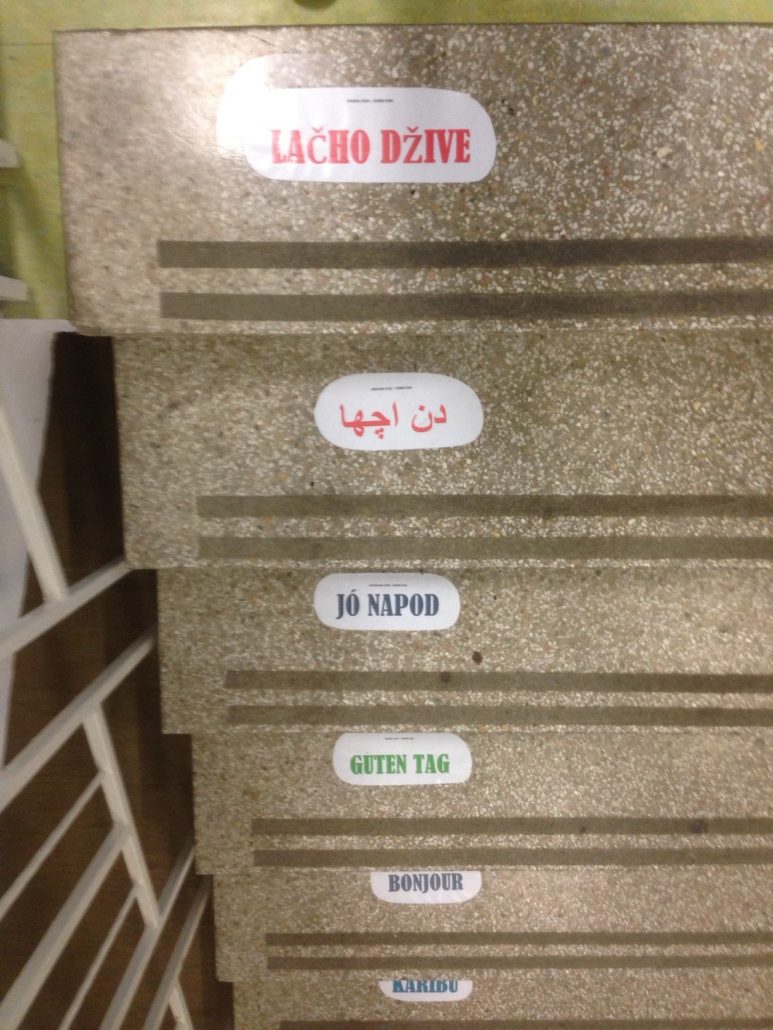
While you are climbing the stairs to the next floor, you are greeted in many different languages which have been painted in a variety of colours. Each step says „Hello“ in the respective language and in the respective alphabet. I really felt welcome to the school.
Whether you are going to the secretary’s office or to visit the director, or are a student on your way to a first floor classroom, you have to climb these stairs. This helps to emphasize the fact that all these people from different backgrounds have something in common.
The pictures are presented side by side and one above the other. Their frames are painted in the colours of the Slovenian flag. The pictures themselves show the flags of the nations represented at the school along with the corresponding number of pupils from that nation. The whole thing is arranged in a big circle in the shape of a strawberry and in between the picture frames is the word „Welcome“ in different languages. There is another circle next to the first one which shows in many colours the letters of „Nasa drzavljanska enoloncnica“, “our state strawberry”. According to the director, 333 children from 27 nations and 8 different languages are currently learning together under this Slovenian umbrella.
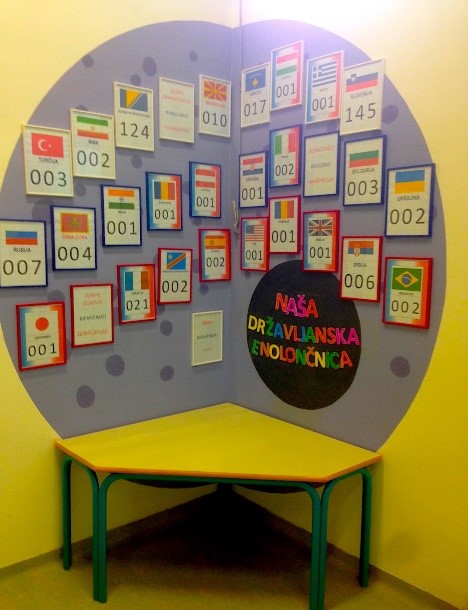
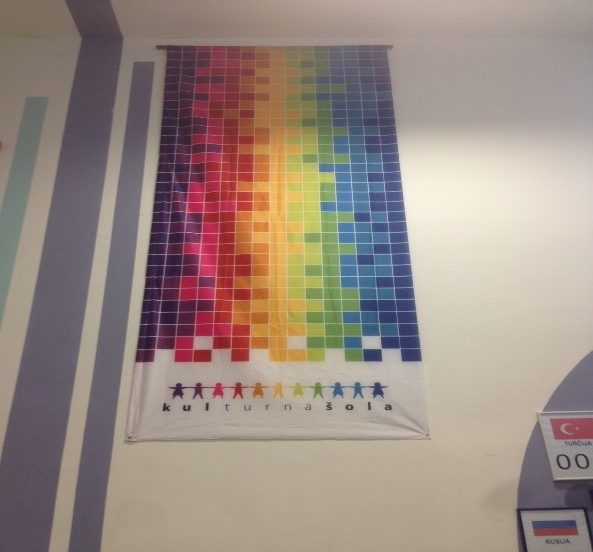
Next to this „installation“ hangs a flag on which small cubes in rainbow colors are arranged side by side and one above the other. Underneath, are children painted in many different colours which are holding hands. And under it is written „kulturna sola“, cultural school.
In the cheerful and friendly dining room, we can see another rainbow. This time colorful children’s handprints form the bands of the rainbow. This handprint rainbow spans the food delivery area. The dining tables are yellow and covered with green tablecloths and the chairs for the children are red, yellow and green. On the wall there are many colorful striped umbrellas. In my opinion, these umbrellas are a sign of protection.
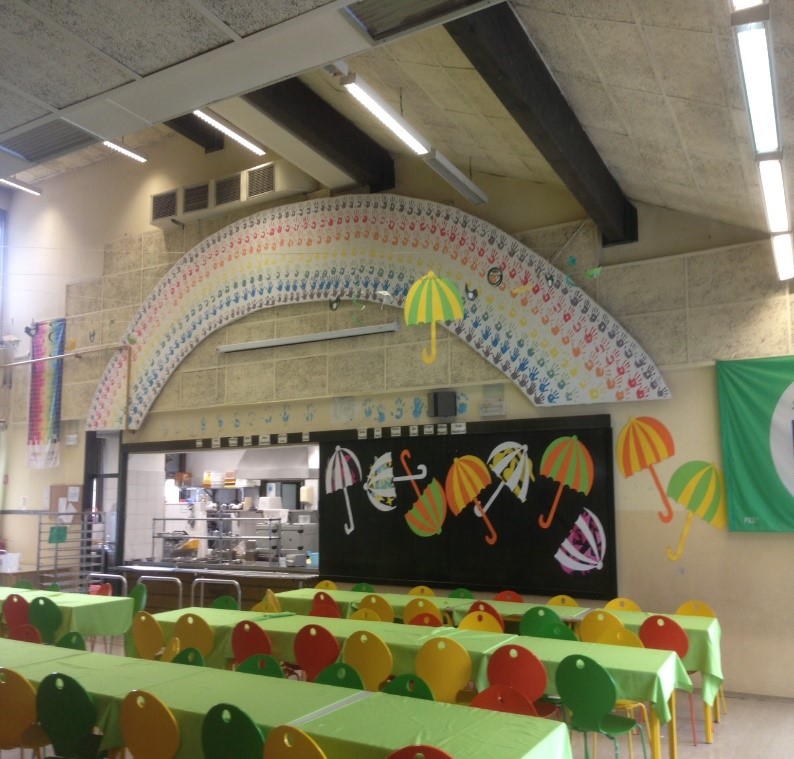
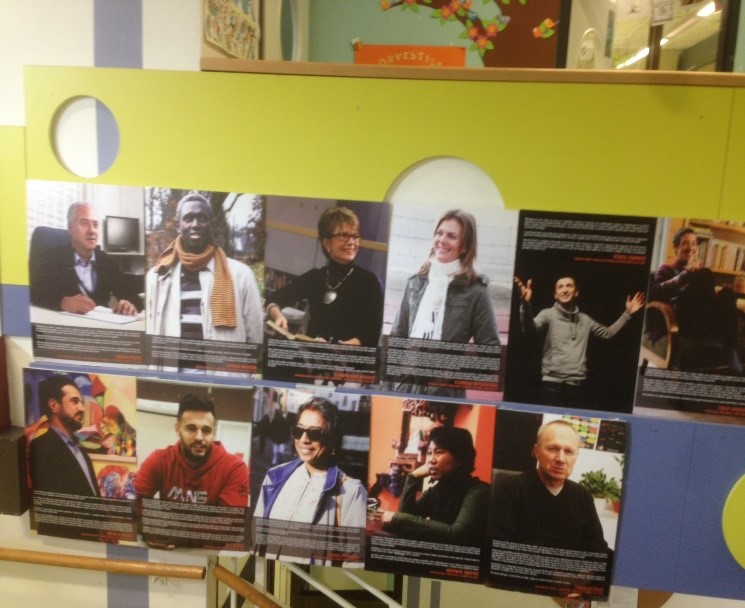
The stairs (see the picture above) tell the children that they are included because everyone is addressed in their own language. In addition, they show that every migrant (symbolized by the Welcome-Greetings) can make their way up to the top. At the top of the staircase hangs a poster with former migrants who have achieved something in Slovenian society and who have succeeded in various disciplines. These people, according to the director, serve as positive role models and as an incentive to try hard at school. They should help the children to realise that anyone can be successful, no matter which country they come from.
These examples made a big impression on me. They radiate an enormous power. I think that in these examples the children are taught that their diversity, their creativity and their own individuality is always in demand and important, and that working together and creating things together brings out the beauty of what they are being taught. They learn that society needs them and that it is up to them to shape that society. The juxtaposition and coexistence of colours as well as the variety of colours, reflects the diversity of the nations and cultures found in the school. The creative visual design of the rooms shows the children that they are welcome. It shows them that colourfulness is something beautiful and self-evident. Colourfulness is only recognizable in the multiplicity. Each individual has their own colour, and when individuals come together, they are colorful. In my opinion, the school highlights that togetherness and mutuality are things that should be sought after so that everyone has an equal and valuable place and is respected. If one individual is missing, it is not that colorful anymore.
The coexistence and respect for each other which can be found in this school also becomes clear in the following story which the director told me: The state wanted to assign 34 children from the asylum center to the school. So first the director asked the parents and after they agreed, the asylum-children were brought into the different classes over several days. Some classes were quite impatient with this procedure and asked when the children would finally arrive.
The communicative level at the school – Language as a connecting element
As far as the communicative and linguistic level is concerned, the school offers a great deal to promote inclusion. Language is a topic in many ways.
Role-playing games regularly take place, in which parents, teachers and students participate together. Based on selected topics, different situations are acted out, which then encourage reflection and subsequent discussion.
In case of problems, the director / teachers will meet the parents and the child or the whole class, depending on the situation, and will try to clarify in a conversation the different points of view. Recurring conversations are also important, I think, because the constant exchange and discussion of problems and facts enables discerning insight.
Talking is a strength of the director, as Ms. M. told me. Through talking he convinced the parents of the migrant-children not to make the children wear headscarves, so no girl wears a headscarf in his school. „Some of the girls in Slovenia have headscarves, but I like the principal’s idea. He visited the parents. He went to the asylum centers and talked to them: ‚You’re welcome and your support is very important for the success of the children.‘ He is a good principle. “
Slovenian as a second language: The director says that the first two school lessons for migrants and refugees are language lessons.The refugees get an extra hour before school starts. So, in total, they have three hours of language lessons every day. For this „priority group“, the director applied for and received an additional teacher from the Ministry. After the language lessons, the children can participate in the normal class together with their classmates. It is especially important that all the students are together in sport lessons because sport particularly facilitates greater linguistic and social rapprochement. The director emphasizes how innovative this idea is. Previously, these language lessons would have taken place only after the normal class. The children were already tired and not so receptive. They did not learn Slovenian as fast as they do now. The director told me when he came to the school as a teacher, it took one year for the children to dare to speak Slovene. Now, with the new measures, they start talking after three months. The students wanted the language lessons.
In the first year, migrants do not need to take exams. They only start taking exams in the second year because by this time, they are able to speak the language better.
Mother tongue is another important factor because it is seen as the basis for the acquisition of new languages. If you are proficient in your mother tongue, then learning another language is easy. Mother tongue means identity for the children and thus security (see also Schiffauer 2002: 40). Courses for Bosnian, Macedonian and Serbian mother tongues are also offered at this school.
These practices and measures reflect the endeavor to integrate children as much as possible and offer them a broad range of linguistic, artistic, social and political activities.
This school exemplifies intercultural competence through which children are strengthened, and in which diversity is perceived as an enrichment. In this school, the idea of working together in harmony is developed. It is here that children learn respect for the other, the stranger.
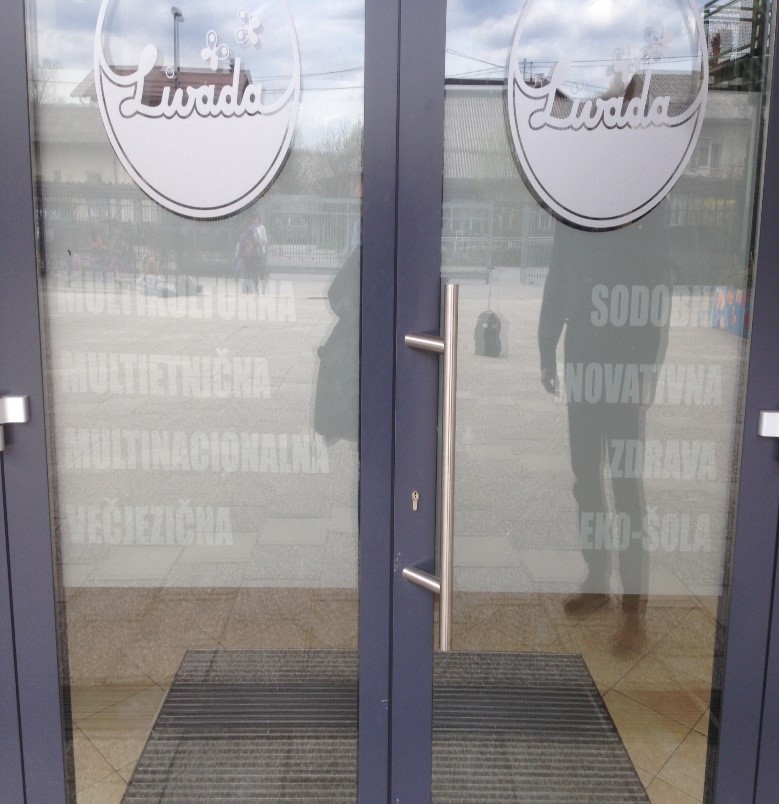
It is only when I am leaving the building that I notice the front door. On the glass door the following is written either as a motto or as guiding principles:
- multicultural
- multiethnic
- multinational
- multilingual
- modern
- innovative
- healthy
- Eco School
This is the program of the school, its claim, its challenge. These are also the guiding principles of the program run by the Research Institute of the Academy (see above). The school shows itself as an institution which is not stuck in the past. Many of the current issues that are important for today are confronted here. Its claim is to deal with the issues of the time. Migration requires a different way of thinking. Regarding the increasing number of migrants and refugees, one has to think of another policy because in the near future a respectful coexistence and a joint shaping of the common living space makes more sense. This ties in with the school’s aim to show itself as modern, innovative, healthy and eco-friendly because these are the topics of the future. Everything happening in this school happens for the future, for the children who will shape and characterize society in the future. And so, it is good that the school and its children deal with the burning issues of the time and learn to find ways to cope with them.
Thus, when entering through the transparent door, you note the difference between the perspective of the people on the outside and those on the inside of the school, and through the words on the door, it is hoped that the exchange which takes place within the school is able to penetrate the outside.
What idea of society is conveyed here and what problems can arise?
Looking at the above-mentioned measures, I think that both the creators of the program and the teachers aspire to a multicultural or intercultural society in which a balanced coexistence of different ethnic groups with equal rights and duties is achieved. Education is designed to foster mutual learning, to see diversity as an opportunity for further education and the broadening of horizons, to cultivate a mutually respectful relationship and to shape life in the coexistence of different ethnic-cultural groups. It is a dynamic and active process that is constantly changing and developing. And it is at school where this process begins.
The training of teachers and the redesigning of curriculum are a high priority in the Slovenian program and for the dedicated teachers. It is the responsibility of teachers to communicate the ideas of diversity and interculturality to their students and to train them to become active citizens of the state. The more confident the teachers are in dealing with these values, the more convincingly they communicate them to the students, which in turn makes it easier for the students to adopt the values themselves. So, it is above all the enthusiasm, the work and the time spent by the teachers that makes programs such as „Le z drugimi smo“ successful. It is their engagement with the broad and continuing educational offerings, their „lifelong learning“ and their development of new concepts in a perpetual process of renewal which the teachers can share (and develop) with the children, who will hopefully take on the teachers’ enthusiasm for themselves.
The children, that is the students, are the bearers of these ideas, which they then carry out into society in order to actively shape society on equal terms. They are the future. They have the power to shape society and promote respect for the „other“.
Werner Schiffauer, who has dealt with migration and integration, describes state education as the „decisive mechanism … through which in nation-states children become citizens and individuals become political people.“ (Schiffauer, 2002: 1). And where the immigrant children are confronted with the civilian culture of the respective society. (Schiffauer, 2001: 233) In his study, Schiffauer and colleagues compare lessons in school-classes with (Turkish) migrants in France, England, the Netherlands, and Germany. And depending on the country and its civic culture, the understanding of the rules, the transfer of knowledge, and the concept of freedom vary. However, it remains a problem in all four countries that immigrants see themselves as a minority. Not even citizenship has made migrants feel like members of the majority society. And this is, on the one hand, because of the „factual discrimination“ that testifies the „virulence of an ethnically defined understanding of nations“, and on the other hand, because „immigrant families tend to emphasize the symbolic boundaries between themselves and the environment“. It is about „how“ the migrants define themselves, „how they draw the lines between themselves and the majority society and between themselves and the other migrant groups“. (Schiffauer, 2001: 247-248)
It became clear that despite the different approaches in the four countries and the well-intentioned initiative of teachers, emphasis is placed on cultural difference and ethnicization takes place (when for example the different (migration) countries are explicitly presented in the classroom, or if migrant children each introduce topics concerning their culture of origin in class). In this way, the contrast between domestic and foreign is particularly apparent. Meanwhile, Schiffauer puts it differently: „The outsider and novice typically makes the experience of integration and discrimination at the same time.“ (Schiffauer 2002: 12)
Another problem may be the constant resistance of citizens of the host country to live with many ethnic groups. Will Kymlicka has studied Canada, where multiculturalism is a state goal. He seeks to counter fears of „impending ethnic revival and separatism“. In his opinion, the politics of multiculturalism promotes the willingness of migrants to integrate. (Kymlicka, 1999: 48-51) It is actually the case that „ethical-cultural diversity does not represent a threat to the social and political integrity of the community, but an enrichment that must be recognized by the state and promoted without compulsory assimilation“ (Ariëns et al., 2012: 12).
For integration, it is important that „multiculturalism … (has to) respect equality between groups and freedom within groups. Actions of other „cultures“ contrary to the democratic understanding of the host country should be rejected: „Such political action is simply incompatible with the freedom of the individual, the equality of citizens and human rights as the value of liberal constitutions.“ (Kymlicka, p. 1999: 63)
This form of political multiculturalism provides for a respectful and equal juxtaposition of different cultures that do not necessarily touch or overlap. The various ethnic groups can retain their idiosyncrasies as long as they are within the country’s democratic framework.
Since Slovenia is a country with a high immigrant population, it seems sensible to work together to ensure equality of opportunity between the various cultural stakeholders. The basic idea is to teach the children through the teachers at school and thus to prepare them for this new common society.
Both the „Le z drugimi smo“ program and the school approach are characterized by the endeavor to pursue and live multiculturalism, just as the schools in France, England, the Netherlands and Germany attempt to do, as Schiffauer describes. These are very ambitious and idealistic efforts. But, they also harbor the danger, as Schiffauer proves on the basis of his study, of ending in a cultural trap and of practicing ethnicization instead of preventing it.
Politics and society are called upon not to let the cultural difference end in a negative loop. The preparation for this should take place at school. The question is whether integration without reoccurring exclusion is even possible because there will always be forces that work against it and use any difficulty that arises to highlight its failure. Nevertheless, the effort is very important and should not stop.
Outlook
Cross-border expansion or cross-border cooperation would be desirable since the issue of migration and possible interculturality is a Europe-wide and overarching issue. Everyone is affected, and everyone should take advantage of the opportunity for diversity. Does it hurt to learn from others?
In this context, I remember the front door of the school. It is transparent. This is an invitation. An invitation to be curious. Curiosity is an essential principle in the learning process. It’s an invitation to see what’s happening on the other side, and it encourages curiosity to get to know the others, the new. One’s own self-developed ideas can be passed on, foreign ideas can be taken in and an exchange and interweaving of the various impulses can take place. This is an uninterrupted dynamic process that leads to finding the best methods for each situation. It is also an invitation to open your own border (and the national border), to make it transparent and free, to give an insight and an outlook, and to carry this freedom and openness with you and make it possible for everyone.
„A teacher must help a child no matter what. Because when you get a young person, this is not responsible for the wars or the politics or their parents‘ action. Are we human beings or not?“ (director)
Literature
Ariëns, Elke/Richter, Emanuel /Sicking Manfred, (Hg.), 2012, (unter Mitarbeit von Eva Onkels und Philip Röhr): Multikulturalität in Europa. Teilhabe in der Einwanderungsgesellschaft. transcript, 2012
Bešter, Romana and Medvešek, Mojca, 2016: Intercultural competence in teachers: the case of teaching Roma students. In: Sobodna pedagogica. Journal of contemporary educational studies 2/p. 26-45.
http://www.sodobna-pedagogika.net/wp-content/uploads/2016/07/2016_2_3_Bester_ang.pdf (13.5.2018)
Boecker, Malte C., 2008: Interkulturelle Kompetenz – Die Schlüsselkompetenz im 21. Jahrhundert? Bertelsmann Stiftung und Fondazione Cariplo. http://www.bertelsmann-stiftung.de/fileadmin/files/BSt/Presse/imported/downloads/xcms_bst_dms_30236_30237_2.pdf (2.8.2018)
IOM: International Office for Migration – The UN Migration Agency: http://www.iom.int/countries/slovenia
Kymlicka, Will, 1999: Multikulturalismus und Demokratie. Über Minderheiten in Staaten und Nationen, Hamburg: Europäische Verlagsanstalt/Rotbuch Verlag
Le z drugimi smo/Only (with) Others are we (2016-2021). ZRC SAZU, Pedagogical Institut: https://lezdrugimismo.si/ (18.7.2018)
Schiffauer, Werner: Staat – Schule – Ethnizität, 2001: in: Gesemann, Frank (Hrsg.): Migration und Integration in Berlin. Wissenschaftliche Analysen und politische Perspektiven. Opladen: Leske + Budrich, , p. 233-250
Schiffauer, Werner, 2002: Staat – Schule – Ethnizität, Politische Sozialisation von Immigrantenkindern in vier europäischen Ländern. Münster: Waxmann
Vizintin, Marijanca Ajsa, 2018: Developing intercultural education, in: Dve Domovini, Two Homelands, 47, p. 89-106
http://www.mizs.gov.si/en/legislation_and_documents/: Republic of Slovenia, Ministry of Education, Science and Sport (2.8.2018)
Zavratnik, Simona, 2006: Contemporary Integration and Asylumn Policies in Slovenia. Rethinking questions of entrance and integration. In: Annales, Ser. hist. sociol. 16, 2, p. 343-354
by Christina Schwichtenberg-Winkler
Quicklinks
Plattformen

Informationen für
Adresse
Universitätsstraße 65-67
9020 Klagenfurt am Wörthersee
Austria
+43 463 2700
uni [at] aau [dot] at
www.aau.at
Campus Plan












